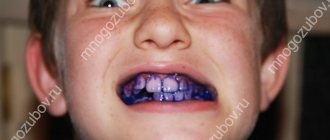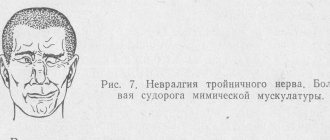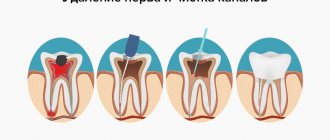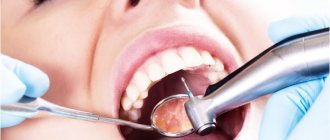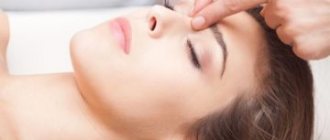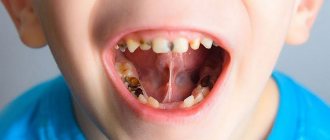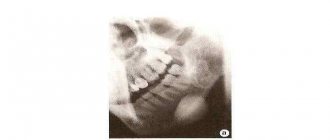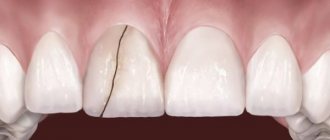Dental nerve - what is it?
In fact, the nerve in the tooth is the pulp. It is surrounded by dentin, which covers the enamel on top. This part of the tooth is responsible for nourishing all other tissues, as well as for sensory perception. Therefore, after its removal, the crown usually fades, acquires a grayish tint, and becomes fragile and brittle. Such a tooth is called dead.
The pulp is a bundle of blood vessels and nerves of the tooth.
As soon as carious processes penetrate deeper into the dentin and reach the pulp, the person begins to experience severe piercing pain. In this case, doctors usually make a diagnosis of pulpitis. But this disease can also be traumatic. With a strong blow, the pulp is damaged and becomes inflamed. If treatment is not started in time, the nerve will have to be partially or even completely amputated. This is necessary to prevent further spread of the inflammatory process and the development of complications, including periodontitis.
Can I use tablets?
Some patients believe that modern analgesics and medications kill the nerve in the tooth. They try to achieve this effect by taking pills daily, in the hope that the nerve will gradually die from their effects on its own, and will not have to go to the doctor. But this is not so, they are only capable of temporarily blocking sensitivity, but not killing.
Naturally, when we begin to experience excruciating pain, it haunts us and we want to quickly find a way to cope with it. The best thing you can do here is take a pill, which will help protect you from pain for a while. Afterwards, you must make an appointment with a doctor. Severe pain will be dealt with by drugs such as Nurofen and Ketanov. Soda/salt rinses will also help. The discomfort will return over time, so you should not count on long-term results.
Nurofen will help get rid of pain
We hope that after reading this material you have drawn conclusions and will not look for information on how to kill the nerve of a tooth at home. Go straight to the doctor. And remember, even if the specialist did everything correctly, the first days after treatment the pain may still bother you a little - and this is an absolutely normal condition. Indeed, when it comes to the pulp, it comes to intervention in the most living and very sensitive tissues of the body.
Notice
: Undefined variable: post_id in
/home/c/ch75405/public_html/wp-content/themes/UltraSmile/single-item.php
on line
45 Notice
: Undefined variable: full in
/home/c/ch75405/public_html/wp-content /themes/UltraSmile/single-item.php
on line
46
Rate this article:
( 3 ratings, average: 5.00 out of 5)
pulpitis
Consulting specialist
Mozhaeva Irina Mikhailovna
Doctor rating: 9.3 out of 10 (7) Specialization: Dentist-therapist Experience: 14 years
In what cases is nerve removal indicated?
With pulpitis, the causative tooth reacts sharply to any mechanical and temperature stimuli. If the neurovascular bundle is already severely damaged, there is no point in trying to stop the inflammatory process, because the risk of relapse is too high. In such a situation, the doctor prescribes removal of the nerve - depulpation. Thus, among the main indications for this procedure, experts in the field of endodontics identify the following pathological conditions:
- advanced caries and pulpitis: when the lesion destroys enamel and dentin and reaches the pulp, it is necessary to either urgently stop the inflammation or remove the affected tissue. The first option is possible only in the early stages of pulpitis, but in practice it is more often necessary to partially or completely amputate the neurovascular bundle,
- complication after unsuccessful treatment in dentistry: in the process of preparing a too large carious cavity, there is always a risk of accidentally injuring the pulp. In such a situation, to correct the error, you also have to remove it partially or completely,
- prosthetics: to install fixed bridges and dentures, it may be necessary to depulpate the abutment teeth,
- mechanical injuries: the pulp can be damaged and inflamed also due to a strong blow. Large chips and cracks in the enamel often lead to similar consequences.
Removal of the nerve is indicated in the treatment of pulpitis
“They removed the nerve from my tooth, but that was a long time ago. Back then, a special medicine was put inside, and something like a temporary filling was placed on top. After 3-4 days you come back for an appointment, and the doctor is already pulling out the dead nerve. I remember while I was waiting for the next appointment, it was unpleasant, the tooth hurt, but it seemed like it should be. I heard that now this procedure is easier, they can do everything in one visit.”
Maxim_Volt, from correspondence on the forum www.32top.ru
Piercing pain in the tooth, which becomes especially unbearable at night, most often indicates the development of pulpitis. However, when the pathological process becomes chronic, acute symptoms may disappear completely. In this case, only a professional doctor can make a correct diagnosis in time. This is one of the reasons why it is so important to have a routine dental checkup every six months.
Tooth weakening - after nerve removal
Because the tooth structure is slightly weakened after root canal treatment, the tooth loses some of its original capabilities. This translates into a higher risk of tooth fractures. Those patients who have had root canal treatment should avoid eating hard foods, such as nuts, or using other teeth to chew on them. To avoid the risk of tooth fracture after root canal treatment, you should consider installing a dental crown.
Failed root canal treatment
Root canal treatment may fail in approximately 5% of patients. This often leads to tooth extraction. Such cases occur for various reasons, sometimes even independent of the quality of canal filling.
How to kill the pulp in dentistry
As for how to kill a nerve in dentistry, specialists for this purpose use two methods of depulpation - vital and devital. The first option involves amputation of the inflamed vascular bundle in one visit, under anesthesia. With the devitalizing method, the removal is carried out in two steps: at the first appointment, the doctor puts a devitalizing paste into the tooth and places a temporary filling on top, and at the second, he amputates the already dead pulp.
Quite aggressive arsenic compounds are used for killing. But today they are gradually being replaced by less toxic formaldehyde pastes. Below we will take a closer look at exactly what medications are used to kill the nerve.
Devitalizing pastes with arsenic: “Devit-Ars” and “Kaustinerv Rapid”
The basis of the drug "Devit-Ars" is arsenic anhydride. It leads to the gradual death of soft tissues and fairly rapid death of the pulp. To make this process painless for the patient, the composition also contains lidocaine.
The photo shows arsenic paste
It should be noted that the process of necrosis of living tissue requires strict control by a doctor, otherwise the consequences for the body can be very serious. It is very important to provide reliable protection against infection during this time. For this purpose, antiseptics are also added to the Devit-Ars paste - eugenol, chlorophenol and metacresol. As a rule, killing with this drug occurs literally within 24 hours1. In rare cases, the process takes a little longer, but usually no more than 2 days.
"Caustinerv Rapid" is another popular devitalizing drug in dentistry based on the same active substance. The composition also contains lidocaine, phenol, hydrochloric ephedrine and menthol. The devitalization process takes on average 2-3 days.
Arsenic-free pastes - formaldehyde
One of the most popular drugs in this category is Devit. It is based on paraformaldehyde, the action of which is aimed simultaneously at killing the pulp and antiseptic treatment of tissues. Lidocaine acts as an anesthetic component, and creosote is responsible for the antimicrobial properties.
Paste without the presence of arsenic can be used
To perform its immediate task, this formaldehyde paste requires much more time - up to 10 days. On the other hand, this is a much more gentle and safe method that poses virtually no threat to the body. Another important advantage of this type of devitalizing agents is the deep sterilization of the pulp chamber, which often makes it possible to preserve tissue at least partially.
Important! After arsenic paste, the doctor must carry out a very thorough treatment of the canals and make sure that there are no traces of a toxic substance there. When using formaldehyde compounds, this step can be skipped.
After 2 to 10 days, depending on the type of composition used, the patient needs to visit the doctor again to complete the treatment. He will remove the temporary filling, remove dead tissue, treat the canals and seal them. A permanent filling will be placed on top and sent for a control x-ray.
How to relieve pain at home yourself
It is worth taking a closer look at the question of how you can calm the nerve yourself before visiting a specialist. You need to understand that such remedies are only needed to mask the symptoms, but they will not help to quickly kill the pulp and relieve you of pain forever. Therefore, you will have to visit the dentist in any case. And if it is not possible to do this urgently, the following traditional medicine recipes will help to relieve the pain and discomfort a little:
- Soda-salt solution is one of the most popular and effective home remedies for relieving acute toothache. A teaspoon of salt and soda should be diluted in a glass of boiled water at room temperature and then used for rinsing the mouth,
You can use a solution of soda and salt - a solution based on 3% hydrogen peroxide also helps reduce the intensity of discomfort. Peroxide should be diluted in warm water in a ratio of 2 to 1, then soak a cotton swab in the resulting solution and apply it to the sore tooth,
- onion peels will help reduce pain and disinfect tissues. To do this, pour 500 ml of boiling water over a small handful of husks and leave for a while on low heat. Strain the finished broth, let it sit for 2-3 hours and then use it for rinsing,
- a mixture of garlic and salt will help reduce inflammation somewhat. To do this, it is placed in an open carious cavity,
- Clove essential oil has pronounced antiseptic and anti-inflammatory properties. It is enough to drop a couple of drops on a cotton swab and cover the painful area with it,
- herbal decoctions of chamomile, mint, lemon balm, thyme, sage and oak bark. You can prepare a decoction of herbal tea or use one type of dried flower.
Herbal decoctions can be used at home
Remember that any attempts to kill the exposed nerve yourself will only lead to a worsening of the condition and the development of dangerous complications. If your tooth hurts badly, try to see a specialist as soon as possible.
Infectious disease - when a nerve is removed
There is a small risk that a tooth after root canal treatment may become infected, like other teeth. If, after treating a tooth with root canal treatment, you notice symptoms of infection (inflammation of the gums, pain “inside the gum” or “above/below the tooth,” etc.), you should immediately contact your dentist for re-treatment.
Some precautions to take after tooth nerve removal and root canal treatment
Have you treated your tooth with root canal treatment? So you must take the following precautions. Most of these instructions apply to all people, even those unlucky enough not to have undergone a root canal procedure.
- Avoid chewing foods that are too hard, such as raw nuts, on a tooth that has had a root canal.
- Brush your teeth twice a day and use dental floss or floss.
- Don't forget to rinse your mouth after meals or snacks.
- Maintain good oral hygiene (periodically changing toothpaste, visiting the dentist for teeth cleaning)
- Get rid of bad habits such as smoking tobacco.
Is it possible to kill a nerve yourself using traditional methods?
Many people are interested in the question of whether it is possible to kill the pulp on their own at home and what folk remedies are best to use for this. The answer will be categorical: such serious dental procedures should be performed by a professional doctor, and nothing else. Otherwise, you risk only aggravating the situation and provoking the development of serious complications.
Therefore, below, for informational purposes only, are the old methods that were previously popularly used to kill a tooth. Here's what they used to kill the nerve, except for arsenic:
- vinegar - moisten a piece of cotton wool in vinegar essence and apply to the causative tooth. Great care should be taken as the essence quickly corrodes enamel and dentin,
- gunpowder - place the substance into the carious cavity, but under no circumstances swallow it, as this can lead to serious poisoning,
- iodine – moisten a piece of cotton wool with iodine and apply it to the hole. You just have to prepare for the fact that it will hurt very, very badly,
Iodine is also used in folk medicine - zinc - burn a piece of newspaper with black ink, collect the ashes on a cotton swab and place it as close to the nerve as possible, leaving it there for about 12 hours,
- arsenic - place a pea of a toxic substance into a cavity in a tooth. It is very easy to fail to calculate the dosage, which can result in serious poisoning of the body and even death.
Under no circumstances should you try to use these methods on yourself. Contact your dentist and undergo the appropriate procedure under the supervision of an experienced specialist. Independent attempts are fraught with dangerous complications.
Ways to deal with pain at home
There are several ways to independently remove pain associated with inflammation of nerve endings. The main goal of home methods is to reduce the sensitivity of the rotted nerve.
- Alcohol. It cannot completely kill the nerve, but it can reduce the activity of pathogenic flora in the carious cavity. It works well as a mouth rinse and reduces the intensity of pain for a while.
- Powder. A small amount of a substance is placed into the affected area, which effectively relieves pain. It is important not to overdo the dosage of gunpowder, since intoxication of the body is possible. We do not recommend using this method, as it is very dangerous.
- Vinegar. The product is pre-mixed with water in a 1:1 ratio, since pure vinegar causes burns to the mucous membranes of the mouth. A cotton swab is moistened in the solution and applied to the carious cavity for 15 minutes.
- Pepper. Preference is given to spices with peas. The product is crushed and placed on the diseased tooth.
One of the most dangerous ways to remove a dental nerve at home is the use of arsenic.
For arsenic to work, it must be placed in previously cleaned dental canals. If even a small dose of the substance enters the intestines, it will be fatal.
All of the above measures are emergency. Even in the absence of re-exacerbation of signs of pulpitis, you should consult a doctor. An infection inside a tooth cannot be destroyed on its own.
To relieve pain, you can use not only folk remedies, but also pharmaceutical preparations intended for dental procedures.
The following solutions are suitable for self-depulpation:
Can a tooth hurt after nerve removal?
- Cresofen. The main active ingredient of the product is dexamezone. The drug is available in the form of drops and has a gentle effect on the mucous membranes of the mouth. The product is used only after pre-treatment of the carious cavity with antiseptics at home. To improve the therapeutic effect, Crezofen is recommended to be used in combination with antibiotics. After using the drug, rinse the mouth with plenty of water.
- Kaustinev Rapid. Consists of 1/3 arsenic solution. The remaining components in the product are considered auxiliary. The duration and frequency of use of the drug depends on how deep the exposed dental nerve is located. If the pulp is located close to the carious cavity, then it is possible to relieve pain symptoms with one application of the solution.
- Davis ARS. Arsenic is also an active component of the drug. The advantage of the medication is the quick and effective elimination of toothaches. The effect of using the product is observed after 1-2 days. The drug is available in the form of syringes or liquid with a universal dosage.
- Devin - P. The drug is available in the form of a paste, which includes analgesic and antiseptic substances: menthol, chlorophenol, camphor oil. This drug is used to relieve the symptoms of pulpitis if medications with arsenic are prohibited for use. Due to the absence of arsenic in the composition, the paste is approved for dental treatment even for children.
Not always products with arsenic can calm the dental nerve at home. This is due to several reasons:
- the impossibility of penetration of the substance into the dental canals due to their location being too deep;
- increased blood circulation in the affected tooth caused by exposure to the substance;
- pain in the treated area due to intoxication with the substance;
- individual intolerance to arsenic;
- The temporary filling is too dense.
You cannot walk with temporary material in your tooth for longer than the period set by your dentist. Otherwise, purulent periodontitis may occur
Instead of peroxide-based drugs, you can use pharmaceuticaldehydes. Hydrogen peroxide and iodine help relieve acute toothache for a while.
What complications can there be from home methods?
Even a doctor during depulpation can make a mistake that will lead to undesirable consequences. What can we say about independent attempts to kill the pulp at home, without following any rules of asepsis and antiseptics. Among the possible negative consequences of such arrogance, experts note nerve separation, severe hemorrhage due to vascular injury, as well as the spread of inflammation to nearby tissues. Other possible problems include:
- allergic reaction to the substances used,
- injury to healthy tissues,
- burn of the mucous membrane,
- loss of taste sensitivity,
- infection and sepsis.
When using home methods, a burn may occur.
Most often, after trying to kill the pulp on their own using traditional methods, patients are faced with a severe burn of the mucous membrane. In other cases, the pulp is burned with preservation but serious damage to the nerve.
What is strictly forbidden to do
There are also several strict restrictions and prohibitions that must be observed to avoid unwanted consequences. Here are the main ones:
- you can’t heat the causal area - no hot compresses, which only intensify the pain and provoke the spread of inflammation,
- you should not take a horizontal position - this will increase blood flow to the painful area, which will make the unpleasant sensations even more intense,
- Under no circumstances should you use needles - some try to pick out the cavity themselves, but this is strictly prohibited. Otherwise, you can provoke severe bleeding and even infection.
In no case should you attach a heating pad to an inflamed nerve.
Killing and removing a nerve from a tooth, even in dentistry, is considered a serious procedure that requires the proper experience and dexterity from a specialist. Therefore, in case of inflammation of the pulp, the help of a qualified specialist – an endodontist – is required. This is not a case where you can do it on your own. Don't risk your health.
1According to information at the office. manufacturer's website: vladmiva.ru.
